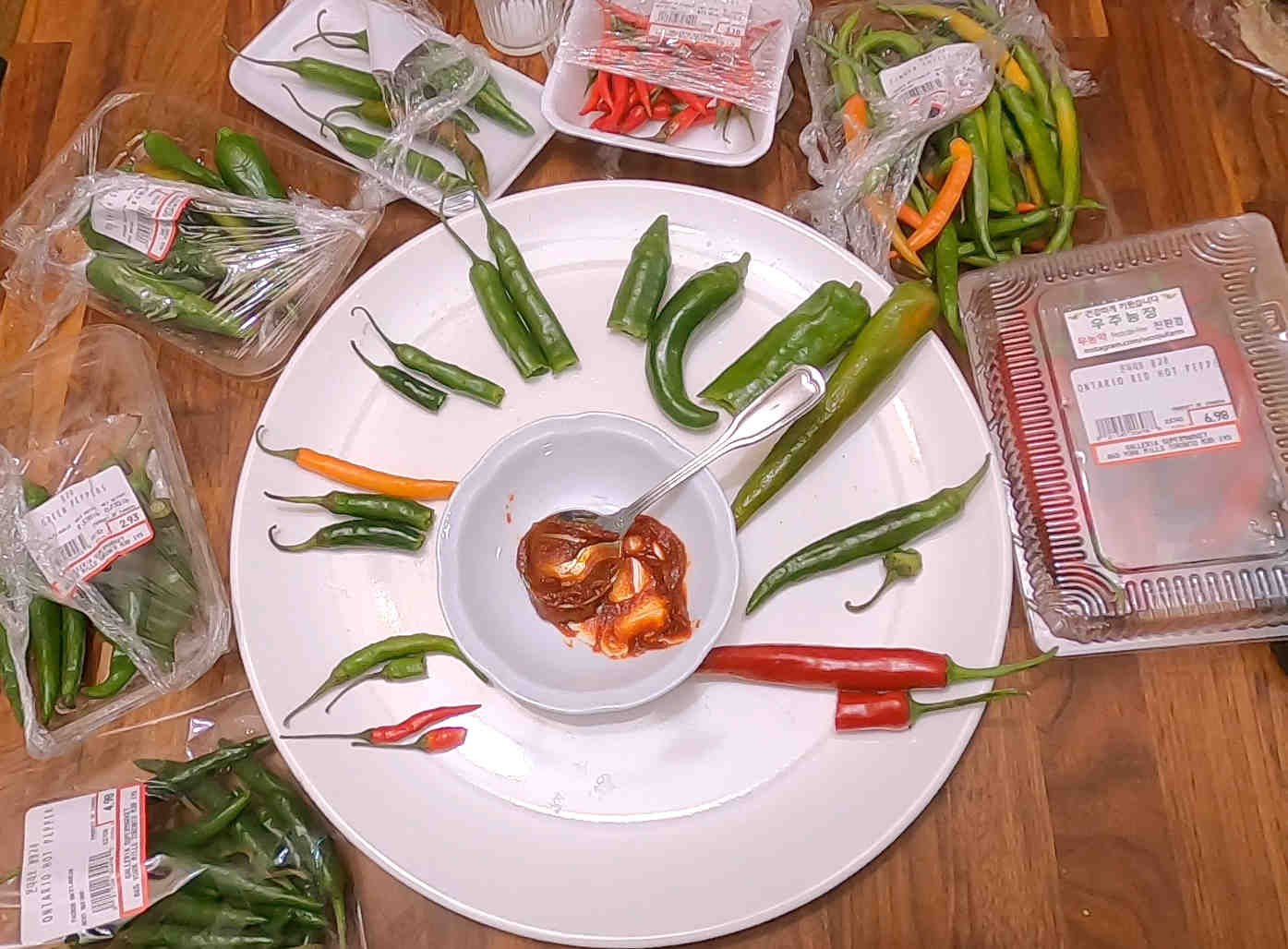Korean Chili Peppers
I got every chili pepper at the Korean supermarket.
“POOT”
풋고추 Poot Pepper is Korea’s main pepper.
You may have encountered some fresh, green peppers placed on the table at the Korean BBQ restaurant. Fresh Korean peppers are meant to be eaten with dip (usually SSAMJANG which is a fermented soybean paste based seasoned dip). These peppers impart a slight kick of spice that helps cleanse the palate and provides refreshing relief from all the meat-eating.
“Gochu” means Pepper in Korean. It’s also used colloquially to refer to a man’s private part. Heh.
Read more about it: All About SSAMJANG
So I wondered, what are all these other peppers sold? Turns out, there aren’t actually as many options as I thought, especially for eating raw with dip.
If you love spice, this is basic know-how, so let’s dive right in.
Korean Chili Peppers
풋고추 Poot Pepper aka Korean Green Chili Pepper
This is Korea’s chili pepper, with a very distinctive flavour. Generally, it has a mild spiciness (of course, depending on the pepper or season, some may not be spicy at all while some will be surprisingly spicy) with subtle bitterness. Koreans will often eat it as a vegetable with dip.
You can easily make SSAMJANG at home by mixing equal parts DOENJANG (Korean fermented soybean paste) and GOCHUJANG (Korean red pepper paste) and adding CHAMGIREUM (toasted sesame oil) to a consistency you like. Think how you sometimes add carrot/celery/cucumber sticks and dip to the table.
Scoville Heat Scale: 1,500 SHU
Read more about it:
On a side note, cucumbers also taste very good with SSAMJANG. Try to buy Asian cucumbers which are skinnier and are crispier and crunchier than English or field cucumbers.
홍고추 Hong Pepper aka Korean Red chili Pepper
This is Poot Pepper (Korean green pepper) that has ripened. It is a very vibrant red. Though they are very beautiful, you won’t often see these eaten raw as their skins have become quite tough. These are mostly used for cooking (adding to soups/stews) or as a dramatic garnish (slice thinly on a diagonal for gorgeous hits of red).
These are usually dried, then ground into GOCHUGARU (Korean red pepper powder), which you know by now is an essential ingredient in the Korean pantry. Go on and read about the Korean essential ingredients here.
Scoville Heat Scale: 1,500 SHU
Read more about it: All About Gochugaru
오이고추 / 아삭이고추 Cucumber Pepper / Crunch Pepper
This is the love child of the Korean Green Chili Pepper (Poot pepper) and the Bell Pepper and my personal fave. Yes, you get the distinctive Korean pepper flavour with the juicy crunch with the subtle sweetness of the bell pepper. This is ideal for people who don’t like spicy foods!
At the same time, remember that you may randomly get one that is (mildly) spicy- chili peppers are a wild bunch! But generally, they are almost tasteless and act as a great neutral base to enjoy a refreshing crunch with the savoury flavour of SSAMJANG.
Scoville Heat Scale: 0 SHU
청양고추 Cheong Yang Pepper aka Korean Spicy Chili Pepper
This is OPPA’s favourite pepper and it packs a punch. Although it seems mild in terms of the Scoville Scale of Pain (kind of on par with Jalapeno Peppers but nothing compared to Habaneros or Serranos!), the amounts used in Korean cooking can have you craving a cold one (milk, that is).
This is not usually eaten raw, with dip. The skin is quite tough and too spicy for most to enjoy. Slice some into soups/stews/dishes to add some heat. This pepper turns red as well when ripe.
Gochujang (Korean red pepper paste) and Gochugaru (Korean red pepper powder) that are categorized as spicier than normal, will have Cheong Yang Pepper added to it (rather than only Hong Pepper).
Scoville Heat Scale: 4,000~12,000 SHU
You may be interested in:
When you go to buy some peppers at the Korean grocery store, these are really the primary peppers you would consider. If you’re planning a Korean BBQ party, get some Poot Peppers (Korean Green Peppers) to add to a plate of veggie sticks (with cucumber and carrot sticks) with SSAMJANG dip. If you seek a hot addition to your cooking, go straight for some Cheong Yang Peppers (Korean Spicy Chili Peppers).
Pick up some Hong Peppers (Korean Red Peppers) if you enjoy garnishing your food. It’s optional imo, and mostly for visual aesthetics. If you buy some but find you’re not going through them fast enough (before they become sad and limpy), slice them thinly and pop them in the freezer. You can add a bit to savoury Korean pancakes or to soups.
Other peppers that can be used in Korean Cooking
손가락 고추 aka Finger Pepper
I mistakenly thought this was a Korean pepper, but it’s actually an Indian pepper called Jwala. It’s known for its spiciness and you’d use it like Cheong Yang Pepper to add heat to dishes.
OPPA says this (not being a Korean pepper), doesn’t have a Korean flavour, but has the heat component that will amplify the spiciness in cooking. Not to be eaten raw as the skin is too tough to be enjoyable. OPPA says this is not hot, but look up Jwala and it’s known to be a spicy chili pepper. You’ve been warned.
Scoville Heat Scale: 4,000~60,000 SHU
Thai Chili Pepper aka Bird’s Eye Chili
This is another favourite to keep in our house when you need even more spice than Cheong Yang Peppers can get you. With very thin skin (meat) and loaded with seeds, Thai Chilis are quite tasteless. They are like fresh little bombs of heat. Easily available at most grocery stores, this is a good one to stock if you are a spice-head.
My sister-in-law has been known to nibble on these raw because she likes that fire-in-the-mouth feeling.
Scoville Heat Scale: 50,000~100,000 SHU
Further Notes on Buying Korean Peppers
We bought both grown in Korea, imported peppers and locally grown in Canada peppers.
The imported peppers are significantly higher in price and I had too high of an expectation I guess. Because we couldn’t discern much difference between them we would just choose the locally grown stuff next time. Buy local and all that, right?
You may find fresh peppers shrivel quite quickly if not used that week. Buying them only when needed and using them up right away would be best, but when that doesn’t happen, freezing them is a good option. Give them a chop or slice them before placing it in a Ziploc bag.
This of course, applies to peppers used for cooking. Pick up the Korean Green Chili Peppers for dipping right when you want them, fresh!
Food eating is a subjective practice. Most will dip veggies in SSAMJANG, but some will just make a runny paste (DOENJANG + CHAMGIREUM) and some people like OPPA’s family (genetic mutants) will dip in straight-up 🔥GOCHUJANG🔥.
Korean Chili Peppers on the Scoville Scale
Bell Pepper 0 SHU < Korean Green Chili Pepper (Poot Gochu) 1,500 SHU < Jalapeno Pepper 2,500~8,000 SHU < Korean Spicy Chili Pepper (Cheong Yang Gochu) 4,000~12,000 SHU < Cayenne Pepper 30,000~50,000 SHU < Thai Chili Pepper 50,000~100,000 SHU < Carolina Reaper 1.4M~2.2M SHU
Do you like Korean peppers?
Have you tried any other peppers that work well with Korean Food?

